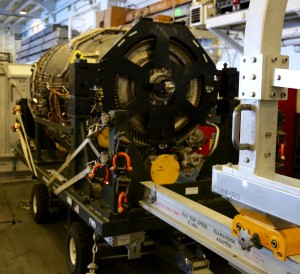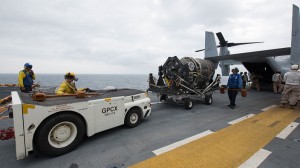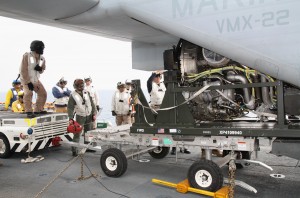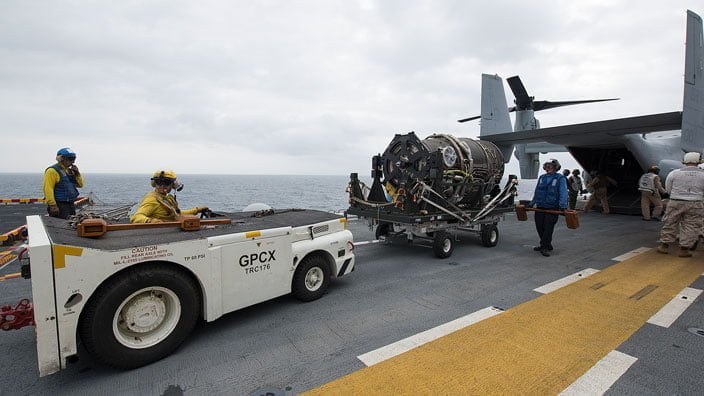2015-06-14 By Robbin Laird
When visiting the USS Wasp and both seeing part of the operational tests as well as discussing those tests with the US and British personnel involved in the testing, one of the highlights was the demonstration of being able to fly the largest module of the F-35B engine directly to the ship via Osprey.
This meant that the speed and range of the Osprey, plus the ability to carry the power module inside the aircraft, provided on-board delivery of a crucial module for future operations at sea for the F-35.
As Lt. Cdr. Beth Kitchen, Royal Navy, OT-1Evoultions Lead, VFMA-501, Beaufort, SC put it during a roundtable during the testing aboard the USS WASP:
One of the bigger successes of this detachment is actually embarking a power module onto the ship, which is about two thirds of the engine.
It was carried on the MV-22, and that arrived last Wednesday, there was a custom made skid that was designed by Pratt and Whitney and put it into the MV-22, it was then offloaded, and then we’ve been able to put it into the hangar and been able to prove that we can move it from the skid it was designed to put into the aircraft onto either a container or one of the maintenance trailers in order to actually conduct the maintenance evolution itself.
That is going to be disembarking tomorrow.
That ensures that we can now replenish a spare module at sea.
It’s a huge achievement to be able to demonstrate that.
But how did the modification of the Osprey occur, and a new capability delivered to the USS WASP, a crucial one in future operations?
It turns out to be an interesting story, one which involved industry working a solution set and offering it to the government and then the Marines and the Joint Program Office funding the effort to go from concept to reality via building a skid to fit inside the Osprey, the one seen aboard the USS WASP.
In a discussion with Pratt and Whitney participants on June 9, 2015, the process was identified and discussed.
Participating in the conference call were Clyde Woltman, now of Aerojet Rocketdyne but formerly of Pratt and Whitney, Michael Chotkowski, the lead for ship integration of the F-35 engine with Pratt and Whitney and Robert Deforge of Pratt and Whitney.

The origins of the approach started with Woltman and the former Deputy Commandant of Aviation, Lt. General (Retired) Trautman working an approach while at a conference and then taking it to the head of Pratt and Whitney who was also attending the conference in mid-2013.
To be clear, this was only two years before IOC of the aircraft, so time was short to ensure a solution to the power module resupply problem.
This started the intellectual ball rolling and P&W led an effort working with Bell and Boeing to shape a way to use the Osprey to carry the F-35B engine power module aboard the USS WASP.
The F-35B engine is composed of a series of modules, which can ease the challenge of moving an engine aboard and off of a ship at sea.
As Chotkowski put it with regard to the engine: “the F-35 engine is modular”.
This facilitates maintenance for one is able to troubleshoot issues within the engine itself and then isolate the problem to a particular module and then swap it out and replace it with a good module.
This allows the maintainer then to put the engine back together and allow it to fly its next mission, instead of requiring test cells to verify the engine.
With regard to the engine for the B, there are nine modules, five of which are engine related and four of them are lift system related.”
But the largest module is quite large and with the surrounding container to protect the engine, a challenge for normal replenishment methods at sea.
The cables to move parts and supplies between a Military Sealift Command (MSC) ships and carriers or amphibious ships max out at 10,000 pounds of lift, and the engine’s power module is about that weight. This means that mods will have to be made to the cabling lift system to move heavier material, such as the power module.
According to Chotkowski: “There is a 12,000 pound lift system developed but it will go only onto new ships that are being built or will need to be retrofitted in existing Nimitz or L-deck ships, and supply ships, which will require investment dollars.”

Alternatively, one can carry the power module below a helicopter like the CH-53 but there are the challenges of safely carrying the engine below the helo while operating at sea as well. And MSC can contract a Super Puma, but you would not want to fly an engine “dangling underneath the aircraft for any length of time,” Chotkowski cautioned.
As Chotkowski explained: “We have containers for each one of the modules for the engine as well as the lift system. The one that presents us the biggest problem is the power module because of the fact that the two methods of resupply available to us for those two service’s, that being vertical replenishment (VERTREP) or connected replenishment (CONREP) are both tasked to their maximum extent of the capability that exists today.”
The Osprey seemed a potential solution to this problem, but it first had to be determined whether the module could fit in the Osprey and then if it did so successfully, could it be transported safely given the operating characteristics of the Osprey itself. Being able to carry the power module inside the Osprey, plus its ability to be refueled meant that the Osprey became a very desirable solution set for the power module supply issue.
To determine whether this could be done, industry invested its own money in an effort to shape a possible way ahead.
According to Chotkowski” “Pratt and Whitney started the process and started to look at the capability of utilizing the V-22 to get the loaf of bread inside the breadbox, so to speak.”
Pratt put together a non-disclosure agreement with Bell-Boeing and the companies began to work on how to do this.
As Chotkowski described the process: Bell Boeing was extremely receptive to working with us on a solution.
So we put together an NDA, and then we kicked off a basic design for length, width, height, maximum: how big is the breadbox, and how big is our loaf of bread, and how can we minimize the profile of a container that will transport this power module, but still keep that loaf of bread secure.
The challenge is that the loaf of bread is almost the same size as the inside of the V22. We had about three inches of play.

We had to make a very low-profile skid, and taking into consideration the basics of does it fit and will it go for the ride?
And go for the ride meaning, the engine’s ability to take whatever shock instances the aircraft incurs, either through landing or during loading, or during flight of the aircraft, as well as vibratory considerations with the V22 itself.
Although the Marine Corps was apprised of this activity, there was no requirement no government funding in place for this project. It was company driven, but customer appraised.
The Marines did fly an Osprey to the P&W facilities in Connecticut during the evaluation process, so that the P&W engineers could have accurate measurements and discuss operations with loadmasters and aircrew to craft a realistic solution set, including loading and unloading the module through the door which was about the size of the module with container cover.
Secretary Stackley, Assistant Secretary of the Navy (Research Development and Acquisition) pushed hard for a solution set for the power module resupply problem and the emerging skid solution seemed to fit the bill.
Industry designed the concept skid. This was an eight to nine month process. But the next step was for the Marine Corps working with the Joint Program Office to build the rapid prototype skid seen aboard the USS WASP. Major General Walsh, Director of Expeditionary Warfare in OPNAV, was instrumental in transitioning the effort from industry to JPO sponsorship, and the JPO money crucial in funding the prototype skid.
In short, the next phase of the Osprey now includes modification to become the key connector for power module resupply for the Navy fleet in support of the USMC.
And this was done by the Marine Corps network in industry, working with the Navy and Marine Corps in shaping a solution funded by the JPO in moving the F-35 program one step closer to 21st Century combat reality.
For the first six pieces of the series on the Osprey see the following:
https://www.sldinfo.com/osprey-at-the-eight-year-mark-preparing-for-the-next-phase/
https://www.sldinfo.com/the-next-phase-for-the-v-22-multi-missionization/
https://www.sldinfo.com/the-price-of-success-can-the-osprey-be-effectively-globally-sustained/


